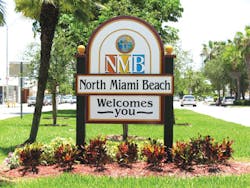City Leverages AMI to Save Water
By Karim Rossy and Jack Merrell
Until recently, the city of North Miami Beach relied on traditional walk up, manual meter reading and a leak detection service that visited quarterly to survey areas of its distribution system. Surveyors would visit two weeks per quarter, helping city staff systematically go from one end of the 550-mile pipeline system to the other in one-mile sections. It took one and a half years to get through the city’s 25-square-mile service territory.
While the city was able to maintain its system and identify leaks, the process was labor intensive and the city understood that automating meter reading and leak detection could be done simultaneously, saving precious time, staff resources, money - and most importantly, water.
It is for that reason that in 2015 the city of North Miami Beach decided to deploy an Advanced Metering Infrastructure (AMI) solution equipped with leak detection technology and cloud-based analytics. With AMI, the city would have the ability to not only collect hourly reads but also survey its distribution system for leaks on a daily basis. It was evident to the city that an AMI solution best suited the vision of North Miami Beach’s long-term strategy to expand services beyond meter reading.
As a part of the AMI solution, the city deployed 38,000 water communication modules along with 11,000 acoustic leak sensors. The system is already providing North Miami Beach with real-time data on customer usage and potential leaks throughout the system. Instead of potentially taking more than a year to identify leaks, the city now knows within three days if a leak occurs. The time-tested, field-proven AMI solution leverages new and evolving technologies and services to solve the city’s most pressing challenges and drive additional business value, including consumer engagement.
With the AMI solution, North Miami Beach is able to enhance customer service, protect revenue, forecast consumption, analyze flow and support district metering by leveraging detailed consumption and meter alerts collected by an analytics application. Later this year, the utility’s customers will have access to detailed consumption information through a secure customer web portal so they can better manage their usage, conserve water and save money. The portal will allow customers to establish their own water use goals and set customized alerts to notify them when they have reached a certain consumption threshold. This promotes consumer awareness of water consumption to aid in conservation efforts.
“Our goal is to drive down costs for the utility and our customers, and reduce the amount of water we produce,” said Ana M. Garcia, city manager for the city of North Miami Beach.
North Miami Beach has already been able to view data from some customer accounts, identifying continuous consumption, which is an indication of a potential customer-side leak of which the customer is most likely unware. With this information, the city has been able to proactively engage with citizens regarding excess consumption before sending out a bill. Customer service outreach has become more proactive, and customers are happy to be alerted that maintenance and other actions can be taken to repair leaks, saving them money in the long run.
With the system’s 11,000 leak sensors installed, the city is now being alerted to leak sounds throughout its distribution system and, following investigation, it has already been able to identify and repair 23 leaks. These leaks are estimated to recover 27 million gallons of water per year, saving North Miami Beach $38,000 annually. In addition to saving money by recovering lost water revenues, the city of North Miami Beach is also recognizing savings from the elimination of physical surveying, minimization of damages caused by unrepaired leaks, and prioritization of utility resources as a result of system automation.
On average, utilities in North America lose between 10 and 30 percent of water that is pumped through their distribution systems, so leak detection can have a significant impact on a utility’s efforts to conserve water and protect revenues. Managing water loss represents an increasingly important factor in budgeting and conservation decisions. The amount of water lost from leaky pipes or recovered with leak detection technology can impact the timing of infrastructure expansion projects by years.
With leak detection technology, the city is maximizing its water supply availability by detecting existing and pre-emergent leaks automatically. It is also able to mitigate pipeline accidents and subsequent infrastructure leakage with an eye toward improving utility operations, maintenance and capital improvement decisions. The technology also minimizes water system operating costs by reducing structural, water quality and hydraulic failures and their adverse effects, while at the same time minimizing life-cycle costs.
With the installation of the AMI solution completed, the groundwork has been laid for additional benefits - not only to the utility but for customers as well. In addition to automated leak detection, which drives costs down for both the utility and customer, the city has been able to improve operational efficiency and enhance safety. The AMI solution improves efficiency of operations and billing with streamlined meter reading, and increases quality of customer service by eliminating the need for estimated bills. The solution also enhances the safety of meter readers, since they no longer have to enter customers’ premises to gather meter reads. In addition, the city’s customers will soon be able to check their own usage via a secure website so they can conserve resources and save money on their bills.
The benefits of the installation for the city of North Miami Beach have been extensive. The city has seen not only cost savings thanks to leak detection but improved consumer satisfaction and a more resourceful community. The development of a more resourceful community stems from both the solutions implemented and the awareness that will soon follow. As consumers gain increased awareness of their consumption, they can take action to address leaks, change behaviors and protect precious water resources.
About the Authors: Karim Rossy is the utilities engineering manager for the city of North Miami Beach. Jack Merrell is the water efficiency manager at Itron. With more than twenty years of experience in the utility industry, Jack has focused on water for the last fifteen, helping utilities leverage technology to improve operations and efficiency.


